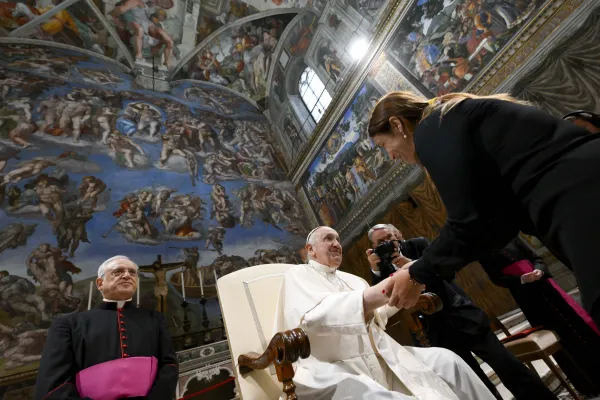Pope Francis addressed approximately 200 prominent artists and other creative people from more than 30 countries in the Sistine Chapel on Friday.
Among the participants was the U.S. photographer Andres Serrano, creator of the controversial 1987 “Piss Christ” image, a photograph of a plastic crucifix submerged in urine.
The meeting with Pope Francis in the Sistine Chapel was organized by the Vatican’s Dicastery for Culture and Education to mark the 50th anniversary of the inauguration of the Modern and Contemporary Art Collection in the Vatican Museums.
Other guests included contemporary painters, sculptors, architects, photographers, writers, poets, playwrights, musicians, actors, and directors.
The pope said the Church has a great friendship with the arts, which can bring much-needed hope to the world through beauty, harmony, and truth.
“Often, as artists, you attempt to plumb the depths of the human condition, its dark abysses. We are not all light, and you remind us of this,” the pope said June 23.
“At the same time, there is a need to let the light of hope shine in that darkness, in the midst of our selfishness and indifference,” he added. “Help us to glimpse the light, the beauty that saves.”
There were nine creatives from the United States, including Abel Ferrara, who directed the recent Padre Pio film starring Shia LaBeouf.

In his speech, Pope Francis said art and faith are alike in that they can both be troubling. “Neither art nor faith can leave things simply as they are: They change, transform, move, and convert them. Art can never serve as an anesthetic; it brings peace, yet far from deadening consciences, it keeps them alert,” he said.
The pope also reflected on art’s connection to beauty.
“As Simone Weil wrote: ‘Beauty seduces the flesh in order to gain entrance to the soul. Art touches the senses in order to enliven the spirit, and it does so through beauty, which reflects things that are good, just, and true,” he said.
“Beauty,” he continued, “makes us sense that life is directed towards fullness, fulfillment. In true beauty, we begin to experie
Pope Francis decried a kind of superficial, or “cosmetic beauty,” and said a way to recognize true beauty is through the presence of harmony.
“True beauty is always the reflection of harmony,” he said. “If I may say so, harmony is the operative virtue of beauty, its deepest spirit, where the Spirit of God, the great harmonizer of the world, is at work.”
He added: “As artists, you can help us to make room for the Spirit.”
Pope Francis decried a kind of superficial, or “cosmetic beauty,” and said a way to recognize true beauty is through the presence of harmony.
“True beauty is always the reflection of harmony,” he said. “If I may say so, harmony is the operative virtue of beauty, its deepest spirit, where the Spirit of God, the great harmonizer of the world, is at work.”
He added: “As artists, you can help us to make room for the Spirit.”



Leave A Comment